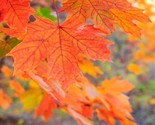Fresh Sugar Maple Tree Plant Seeds Inside US Fast Shipping
Sugar Maple, Acer saccharum Tree (Northern Source)
Brilliant Fall Colors, Shade Tree, Bonsai, Attracts Birds, Wildlife Food/Shelter, Wind and Urban Tolerant
Sugar Maple is a large, moderate to slow growing, long lived deciduous tree. It will typically grow 40 to 80 feet tall (sometimes to 100 feet) with a large dense, rounded crown and a trunk up to 3 feet in diameter. It is one of the giants of the forest providing abundant shade and beautiful fall foliage. Sugar Maple has deeply furrowed gray bark which turns almost black when wet. Its leaves are medium green, opposite, palmately lobed (3 to 6 inches wide with 3 to 5 lobes) turning brilliant yellow, orange and red in autumn. Fruit are two-winged horseshoe-shaped samaras about 1 inch long, appearing in clusters, brown when mature in the fall. Sugar Maple grows about 1 foot each year in most soils but is sensitive to reflected heat and to drought, turning the leaves brown (scorch) along their edges. Leaf scorch from dry soil is often evident in areas where the root system is restricted to a small soil area, such as a street tree planting. It is more drought tolerant in open areas where the roots can proliferate into a large soil space.
Sugar Maple is a main component of the Eastern U.S. hardwood forest and is one of the trees which are most responsible for giving New England its reputation for spectacular fall color. This majestic tree is an excellent choice for larger landscapes, parks, and estates. It is not particularly tolerant of air pollution, though. Native Americans taught the early colonists how to tap these trees to make maple syrup which has now become a multi-billion dollar industry in the U.S. and Canada. It's an important timber tree in the forest products trade, as well as the source of maple syrup and sugar, a major industry in the northeastern U.S. The sap is tapped from the trees in early spring and then boiled down until it is thick enough to be called syrup. It takes about 40 gallons of sap to make one gallon of syrup. Don't try this in the kitchen - you'll have a layer of sticky film on the walls and ceiling. Charcoal made from Sugar Maple is used to "mellow" Jack Daniels whiskey.
Sow seed directly outdoors in the fall or plant stratified seed in the spring. Seed of the sugar maple (Acer saccharum) should be stratified for 40 to 90 days at 33 to 41 F, while seed of the Plant the seed (fruit) 1/4 to 1 inch deep.
Other Names: Sugar Maple, Hard Maple, Rock Maple
Zone: 3 to 8
Growth Rate: Slow-Medium
Plant Type: Medium-Large size deciduous tree
Family: Aceraceae
Native Range: Eastern North America
Height: 40 to 80 feet
Spread: 30 to 60 feet
Shape: Upright oval when younger. Large, dense and rounded crown when mature.
Bloom Time: April
Bloom Color: Greenish
Flower/Fruit: small yellowish green flowers, before leaves in April followed by samaras, 1" to 1.75" inches long as a pair they form a horseshoe shape
Sun: Full Sun to Part Shade
Fall Color: Very Showy; Brilliant yellow, orange and red
Drought Tolerance: Moderate
Water: Medium
Maintenance: Medium
Site Requirements /Soil Tolerances: Easily grown in average, medium, well-drained soil in full sun to part shade. Prefers fertile, slightly acidic soil. Shade tolerant.
Seeds Germination:
Plant
the seeds about three-quarters of an inch (2 cm.) deep in moist peat
moss or folder the paper towel, then place them in a plastic bag inside
the refrigerator for 60 to 90 days. Place the pots in a warm location when they
come out of the refrigerator, and once they germinate, place them in a sunny
window. Keep the soil moist at all times
Stratification is achieved either by sowing
maple seeds outdoors in the fall in temperate or cold regions or by
refrigerating the maple in an appropriate medium. Placing the seeds and moist,
but not wet, peat moss, sand, perlite or vermiculite in a bag or container with
a small opening or holes to allow slight air flow and re-moistening the medium
as needed to prevent drying is key to maintaining the stratification
environment.
The ideal length and temperature for
stratification varies between maple species, but most germinate best following
40 to 90 days of cold treatment at 33 to 41 degrees Fahrenheit. When
several of the seeds begin to sprout, they are ready to plant.
Customer Service:
Your success is our success. If you feel like you cannot leave us a 5 star rating or if you have any issues with your order, like damaged or wrong items etc...just send us a note and we'll promptly resolve the issue for you.
Free Shipping:
Seeds are packaged in a small poly bag. In an effort to keep costs low, and pass the savings onto you, we do not offer specific planting directions on seed packets. If you cannot locate planting instructions for your specific conditions, contact us and we'll do our best to instruct you on the proper methods.
There is no tracking number for economy shipping. Economy shipping order usually takes 1-2 weeks to arrive depending on the state you live. If you want seeds to arrive faster and safely with the tracking, it is HIGHLY recommended to choose USPS Ground Advantage.
